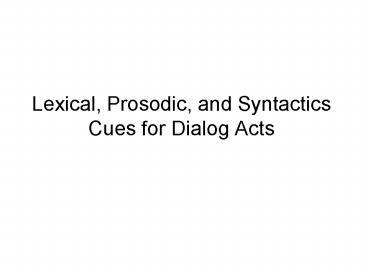Lexical, Prosodic, and Syntactics Cues for Dialog Acts - PowerPoint PPT Presentation
1 / 15
Title:
Lexical, Prosodic, and Syntactics Cues for Dialog Acts
Description:
Lexical, Prosodic, and Syntactics Cues for Dialog Acts – PowerPoint PPT presentation
Number of Views:63
Avg rating:3.0/5.0
Title: Lexical, Prosodic, and Syntactics Cues for Dialog Acts
1
Lexical, Prosodic, and Syntactics Cues for Dialog
Acts
2
Purpose
- Investigating the particular class of dialogue
acts called backchannels (aka "acknowledgement
tokens"). Those give feedback to the speaker. - Continuers an utterance indicating that the
other speaker should go on speaking. - incipient speakership
- agreements marks the degree to which a user
accepts the speakers opinion, statement, etc. - yes-answers
- Assessments ascriptive sentences expression of
a certain property ("good," "bad").
3
Questions
- Does it have any importance as cue-phrases for
the structure? - Does prosodic knowledge have any importance?
- Is there any difference in syntactic realization
of certain dialog acts, compared to others?
4
Who Cares?
- Part of a project to "automate discourse
structure for speech recognition and
understanding tasks" - Create models of speakers and dialog.
5
Materials and Methods
- -SWBD-DAMSL dialog tagset
- an adaptation of DAMSL tag-set
- 60 labels that could be combined in different
dimensions. - -7 CU-Boulder linguistics grad students labeling
switchboard conversations of human-to-human
interaction
6
Results
- 220 unique tags for 205,000 utterances, where
each utterance received exactly one tag. - Good agreement rate between labelers (84), but
too many tags for statistical analysis ?
everything was condensed into 42 final tags
7
On the lexical level, do words like "yeah" have
any importance as cue-phrases for the structure?"
- Hirschberg Litman "now" and "well."
- Here words with overlap meanings
- Jurafskys Findings
- utterances may be ambiguous, BUT through the
lexical form, we could find the word's true
"identity."
8
"Yeah" Vs. "uh-huh"
- Yeah" (and variations) ambiguous ("agreements"
at 36, at "incipient speaker" at 59", and 86
at "yes-answers") - "uh-huh" (with its variations) a "continuer"
(45 vs. "yeah" at 27).
9
Next Question "Does prosodic knowledge have any
importance in determining DA's meaning?"
- Hirschberg and Litman intonational phrasing and
pitch accent disambiguates cue phrases and help
determine discourse structure. - Jurafsky agrees.
- Runs experiment Text transcription vs. complete
speech
10
MATERIALS AND METHODS
- 44 random, but previously labeled conversations.
- Conversations were put in full context as well as
fully transcribed AND the original labeling was
also available. - RESULTS 98 agreement!
11
2
- The shifts
- 38 of the 2 continuers ? agreements
- 19 of the 2 opinions ? statements
- 15 of the 2 statements ? opinions
- Etc.
12
Why the Shifts?
- due to cascading changes (continuer ? agreement,
preceding statement opinion). - Nature of labeling instruction ambiguous cases
were labeled as continuers - Identical lexical form some speakers
distinguished agreement from continuer based on
prosody, while others used lexical form.
13
Take Home Message
- Continuers are, in most cases (vs. agreements)
- shorter in duration
- less intonationally marked
- long pauses before speaking
14
3rd QuestionIs there any difference in syntactic
realization of certain dialog acts, compared to
others?
- Goodwin and Goodwin
- Pro Term Copula (Intensifier) Assessment
Adjective - Formula happens frequently, where
- pro term mostly equals "that"
- intensifiers are rare, and are usually "really,"
and "pretty" - assessment adjective has small range of
adjectives great, good, nice, wonderful, etc.
15
Syntactic Conclusion
- "micro-syntax" restricted grammatical
production than would have thought. That is,
certain dialog acts have their own syntactic
patterning.

